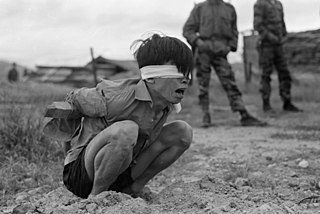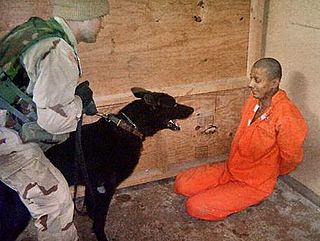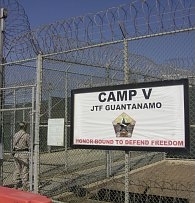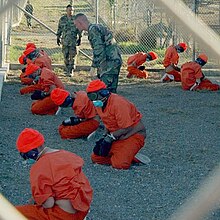Brainwashing, also known as mind control, menticide, coercive persuasion, thought control, thought reform, and forced re-education, is the concept that the human mind can be altered or controlled by certain psychological techniques. Brainwashing is said to reduce its subject's ability to think critically or independently, to allow the introduction of new, unwanted thoughts and ideas into their minds, as well as to change their attitudes, values, and beliefs.

Torture is the deliberate infliction of severe pain or suffering on a person for various reasons, including punishment, extracting a confession, interrogation for information, or intimidating third parties.

Interrogation is interviewing as commonly employed by law enforcement officers, military personnel, intelligence agencies, organized crime syndicates, and terrorist organizations with the goal of eliciting useful information, particularly information related to suspected crime. Interrogation may involve a diverse array of techniques, ranging from developing a rapport with the subject to torture.

A forced confession is a confession obtained from a suspect or a prisoner by means of torture or other forms of duress. Depending on the level of coercion used, a forced confession is not valid in revealing the truth. The individuals being interrogated may agree to the story presented to them or even make up falsehoods themselves in order to satisfy the interrogator and discontinue their suffering.

Waterboarding is a form of torture in which water is poured over a cloth covering the face and breathing passages of an immobilized captive, causing the person to experience the sensation of drowning. In the most common method of waterboarding, the captive's face is covered with cloth or some other thin material and immobilized on their back at an incline of 10 to 20 degrees. Torturers pour water onto the face over the breathing passages, causing an almost immediate gag reflex and creating a drowning sensation for the captive. Normally, water is poured intermittently to prevent death; however, if the water is poured uninterruptedly it will lead to death by asphyxia. Waterboarding can cause extreme pain, damage to lungs, brain damage from oxygen deprivation, other physical injuries including broken bones due to struggling against restraints, and lasting psychological damage. Adverse physical effects can last for months, and psychological effects for years. The term "water board torture" appeared in press reports as early as 1976.
This article describes the use of torture since the adoption of the 1948 Universal Declaration of Human Rights (UDHR), which prohibited it. Torture is prohibited by international law and is illegal in most countries. However, it is still used by many governments.

Mamdouh Habib is an Egyptian and Australian citizen with dual nationality, best known for having been held for more than three years by the United States as an enemy combatant, by both the Central Intelligence Agency (CIA) and military authorities. He was sent by extraordinary rendition from Pakistan to Egypt after his arrest. He was held the longest at the Guantanamo Bay detention camp as an enemy combatant. Finally released without charges in January 2005, Habib struggled to have his account of his experiences believed, as he alleged he had been tortured by the CIA, Egyptians, and US military, at times with Australian intelligence officers present. For some time, each of the governments denied his allegations, but they have gradually been confirmed.
Extrajudicial prisoners of the United States, in the context of the early twenty-first century War on Terrorism, refers to foreign nationals the United States detains outside of the legal process required within United States legal jurisdiction. In this context, the U.S. government is maintaining torture centers, called black sites, operated by both known and secret intelligence agencies. Such black sites were later confirmed by reports from journalists, investigations, and from men who had been imprisoned and tortured there, and later released after being tortured until the CIA was comfortable they had done nothing wrong, and had nothing to hide.

Psychological torture or mental torture is a type of torture that relies primarily on psychological effects, and only secondarily on any physical harm inflicted. Although not all psychological torture involves the use of physical violence, there is a continuum between psychological torture and physical torture. The two are often used in conjunction with one another and often overlap in practice, with the fear and pain induced by physical torture often resulting in long-term psychological effects, and many forms of psychological torture involving some form of pain or coercion.

The Guantanamo Bay detention camp is a United States military prison within the Guantanamo Bay Naval Base, also referred to as Gitmo, on the coast of Guantánamo Bay in Cuba. As of April 2023, of the 779 people detained there since January 2002 when the military prison first opened after the September 11 attacks, 740 had been transferred elsewhere, 30 remained there, and nine had died while in custody.
Amnesty International USA (AIUSA) is an American non-profit non-governmental organization that is part of the worldwide Amnesty International organization.
There are cases, both documented and alleged, that involve the usage of torture by members of the United States government, military, law enforcement agencies, intelligence agencies, health care services, and other public organizations both in and out of the country.
White torture, often referred to as white room torture, is a type of psychological torture technique aimed at complete sensory deprivation and isolation. A prisoner is held in a cell that deprives them of all senses and identity. It is particularly used in Iran; however, there is also evidence of its use by Venezuelan and United States intelligence services.
Music can be used as a tool of psychological warfare. The term "music torture" is sometimes used to describe the practice. While it is acknowledged by United States interrogation experts to cause discomfort, it has also been characterized as having no "long-term effects".
The Guantanamo Trap is a documentary film about four individuals whose lives were changed by their association with the Guantanamo Bay detention camps. The film was directed by Thomas Wallner and won the special jury prize at the 2011 Hot Docs Canadian International Documentary Festival.

Interrogational torture is the use of torture to obtain information in interrogation, as opposed to the use of torture to extract a forced confession, regardless of whether it is true or false. Torture has been used throughout history during interrogation, although it is now illegal and a violation of international law.
Richard Patrick Zuley is a former homicide detective in the United States who had a 37-year career in the Chicago Police Department. He is most known for obtaining confessions from suspects by torture. Since the early 2000s, some of these convictions have been investigated and overturned as wrongful, following allegations that he had tortured and/or framed suspects. Since 2013 he has been the subject of several civil suits from inmates claiming abuse and frame-ups to gain convictions.
Statements obtained under torture are not admissible evidence in court proceedings in many jurisdictions.
According to UN experts, the Guantanamo Bay detention facility in Cuba is a site of "unparalleled notoriety" and has been condemned as a site of "unrelenting human rights violations." The facility has been holding prisoners for over 20 years. A document released by the Amnesty International reported ongoing and historic human rights violations at the Guantánamo Bay detention facility.

During the Israel–Hamas war, the systematic torture of Palestinians by Israel was reported by the United Nations, Human Rights Watch, Amnesty International, and several Israeli nonprofit organizations. Israel was accused of sexual violence against both male and female Palestinian detainees, as well as torturing United Nations staff in order to extract forced confessions. From October 1923 to March 2024, 27 Gazan detainees died in Israeli military facilities. There were further reports of the Israeli torture of accused militants. In response, Shin Bet officials stated they conduct militant interrogations within the Israeli legal framework, which allows torture only under specific circumstances.








